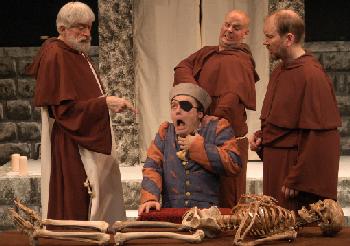Michael Hollinger's
Incorruptible is described as a dark comedy about the Dark Ages, and it certainly has many elements of humor. As for corruption, there is plenty of that as well. Despite the fact that the play occurs in a monastery, no one is safe from corruption. In fact, Jack says it best on page 53: "I've done more sinning since I joined the church!" Despite the fact that he is a deceitful, Pagan minstrel, he is responsible for bringing the church back to its senses.
 |
| Jack being choked by Martin.* |
The play begins with a church that is so poor, it cannot afford to help the community. In addition, the people are not allowed to pray unless they pay a penny for each pray. Perhaps this was the kernel of truth that prompted Hollinger to write the play as the Catholic Church had a similar system during this time. However, not only was the church unable to afford to help the community, it appears that Martin would find an excuse to not. Martin is the center of corruption in the story who ends up influencing the rest of the monks, including the abbot.
 |
| The cast of Carpenter Square Theatre's rendition, centered around the altar with the remains of Saint Foy.* |
Martin leads the church astray, not even willing to bury a murdered man because of his religious beliefs. He is more focused on how he plans to run the monastery once Charles dies. They know that Saint Foy has not granted any miracles for them but do not conceive that it could be their faith or disrespect for her. When a convent receives the Pope's attention for having Saint Foy's remains, and conducting multitudes of successful miracles, Martin refers to them as a "second-rate convent run by a bunch of backwoods nuns (14)." They set out to find the truth.
 |
| The monks around Saint Foy's remains.* |
Once they learn the truth, the monks set up a scheme to sell bones to churches while passing them off as saints. To their surprise, the "Saints" are producing miracles, while their own Saint Foy does not. They become some enchanted with making money that they lose count of the number of remains they sell-- John the Baptist had seventeen heads. Martin even tells Olf to dig up the remains of a dog in hopes of making a profit off of it. Then Martin receives a letter from the Pope, who he had been secretly contacting with promises of a true miracle: an incorruptible, stating that the Pope was coming. Martin and Charles entreat Brother Norbert, Jack, to kill someone for this purpose.
 |
| The monks leaning over a sack containing "Saint" remnants.* |
The characters are fleshed out a little bit as Jack lies about his chastity; his fiance (I think it's the best way to describe her) has been coming frequently. Marie informs him that she is just a body to everybody in her life and that she doesn't know who's baby it is because her mother has sold her to the night. Felix's story about his fiance is brought to the forefront. Eventually, Agatha informs Charles that it was her idea to put the sawdust in the bread and uses the same rhetoric as Martin to describe the monastery.
 |
| Marie and suitor.* |
Felix discovers that his fiance survived and is Marie. Agatha discovers that truth about the bones industry and the incorruptible scam and instead of exposing them, hopes to get a cut. They threaten to cut the girl in half, much like the Biblical story where the king was coming to cut the baby in half and discovers who the true mother is. Jack helps Felix and the pregnant Marie escape and then puts Saint Foy back on the altar. He has suddenly gained faith and his eye is healed. Charles understands and is overwhelmed as well. However, the two characters have realized their corruption.
We certainly have interesting timing as this past Sunday was All Saint's Sunday.
*All images obtained from Google Image Search




No comments:
Post a Comment